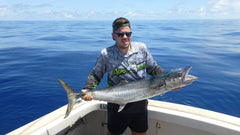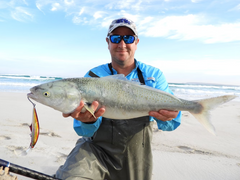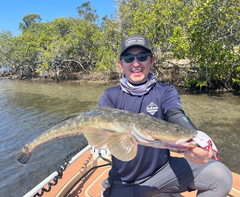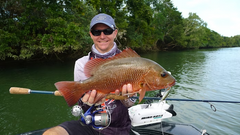By Robert Thornton
Flathead are easily one of the most popular target species across Australia, and by far the most sought-after variety is the dusky flathead. This enigmatic animal has captured the imaginations of countless anglers over generations, and entire techniques and angling markets have been built around them.
They are best known as a popular target for lure and fly anglers, however chasing them with bait is a viable and rewarding technique as well. In fact, bait fishing is a good way to specifically target larger duskies, particularly in places that receive a lot of angling pressure.
But before we get into how to catch flathead on bait, let’s take a look at our target species!

Dusky flathead facts
Dusky or mud flathead (Platycephalus fuscus, which literally means ‘flat head dusky’), exist in the intertidal zones and estuaries all the way from about East Gippsland in the south and all the way up the East Coast to about Cairns. They are the largest flathead species, growing to over a metre, and their colouration can vary from a sandy yellow to almost black, often with speckles or mottles to help them blend in with their environment.
Duskies are generally an ambush feeder, meaning they will wait in areas where live prey is brought to them, such as at the mouth of drains and creeks or on the edges of drop-offs. They’re also capable of short bursts of speed, and will sometimes chase down prey over short distances, however they prefer not to move too far if they don’t need to.
It’s worth learning a bit about their breeding habits in your local area, as this is a good time to target larger specimens. They’re breeding seasons happens at different times throughout their range, with the general rule being cooler months for northern strains, spring for the middle latitudes and summer for southern fisheries.
During their spawning they will school up, with a dozen or so smaller males (around 30cm long) gathering around large, lone females sometimes over a metre in length. If fishing during these times and you land a smaller flathead, it can be worth persisting in that spot, as there’s a good chance a larger female will be present.
Flathead tackle
Flathead fishing with bait isn’t too complicated, and can usually be done with gear you already have, however technique specific tackle will always help you to present your baits better, fish more confidently, and in turn land more fish.
When lure fishing for flatties, anglers usually like a slightly stiffer rod to both work the lures erratically, and set the hook through the bony upper jaw of the fish. When fishing with bait, however, most prefer a rod that is sensitive enough to pick up flathead bites. A bit of softness also allows them to get the bait in their mouth without feeling too much resistance.
If fishing from the shore, whether in an estuary or along a beach, a longer rod between 8-10ft is a good option, preferably something with a soft action. Shimano’s Aerowave Graphite Surf 19AWG963 and Daiwa’s Crossfire Surf 862L are both shorter beach style rods that can be used in just about any shore fishing scenario and offer the sensitivity and softness that this technique demands. Even if fishing in the surf, it’s likely that you’ll be fishing fairly close to your feet, and a rod longer than 10ft isn’t really necessary.
Those fishing from a boat can get away with shorter rods, and generally speaking shorter rods are more practical in the boat. Shimano's Taipan 21TP802EST is a good boat option, and its fibreglass design makes it a nice soft-actioned rod perfect for bait fishing.
Reels are not a super important part of the equation, however most flathead fishing with bait is done with either spin or side cast reels. What is more important is the line you spool it up with. If you’re fishing with a particularly long, soft rod, braided mainline may be a better choice, as this will give you the sensitivity you need in such a soft system. With shorter or stiffer rods, monofilament mainline can give the extra shock absorbance needed to reduce resistance.
Many anglers like to use bait and lures with the same set up, and in this case it would be better to use braid. Mainline’s of around 6-10lb are usually fine, however you will need to put a bit more thought into your trace. Flathead like to eat their prey whole, and possess sharp, raspy teeth – a bad recipe if using baits and light traces.
When choosing a trace, it’s a good idea have 13lb mono or fluorocarbon as your minimum, with 15, 30, and sometimes 30lb needed if you’re chasing larger specimens. In days gone by, anglers would sometimes use a length of single-strand wire to prevent bite-offs, however having wire in the system can put fish off. Berkley Vanish is an excellent trace material, especially in the lighter poundages. Anyone wanting to chase the big girls would do better using Black Magic Tough Trace, which is optimised for high abrasion resistance.
Flathead rigs and baits
There’s more than one way to catch flathead on bait – in fact, there’s many ways! In this blog, I will outline a few of the less complicated rigs and baits for this style of fishing. A running sinker rig, with either a ball or pea sinker and a 1/0 suicide hook (Mustad’s Big Red Suicide and Black Magic’s Wasabi Suicide Black are good models) is about as simple as it gets, but is very effective if using smaller dead baits, especially if you don’t mind catching a few other species as by-catch. This is a good ‘all-rounder’ and is cheap and easy to rig up.
If you want a slightly more natural presentation, tying in a swivel about 30-50cm up from the hook, with your sinker sitting above the swivel, is a good way to go. Rigging a bait this way will allow the current pick the bait up a little bit and waft it around.
For live baits, larger hooks around 3/0-4/0 are a better idea, and circle hooks like Mustad’s Demon Circle Hooks or Black Magic’s KL Circle Hooks are proven performers. The beauty of circle hooks is that they mitigate the risk of hooking larger fish too deep, meaning these bigger models can be released without any internal harm.
Depending on the area you’re fishing, live baits can be fished with or without weight. Over shallows areas, an unweighted bait can be extremely deadly, and every bit as exciting as fishing with lures!
If you’re looking to keep your live bait relatively stationary in a particular hole, in front of a drain or something similar, a running swivel rig with an appropriate size sinker will serve you better.
Your sinker size should always be just heavy enough to keep your bait in place, but not too heavy that is bombs straight to the bottom and spooks fish. Now to baits! And this is an area that could get very philosophical, because you can catch flathead on a huge variety of baits. While most standard dead baits like packet prawns, mullet gut, worms, and even kitchen baits like steak, raw chicken and so on will work, they will also attract a lot of undesirable species. Pilchards and whitebait are top tier dead flathead baits, however these too will attract other welcome and unwelcome visitors.
Live baits are a way to specifically target dusky flathead (particularly larger ones), as flatties are hunters that prefer live prey. Poddy mullet, herring, legal whiting, yabbies and prawns are fantastic live flathead baits, however you may have to collect them yourself, but as they say, it’s all part of the fun. A live bait between 5-10cm is a good starting point, although big flatties will happily engulf a 15cm livey (and bigger) if they’re hungry.

Fishing for flathead with bait
As we discussed before, flathead will tend to find an area to ambush their prey, and won’t move too far during a tide cycle. The good news for anglers is that they will feed throughout the cycle, however they will reposition themselves so they don’t get stranded high and dry, and so that they are always in the optimal position to strike.
At higher stages of the tide, flathead are generally a little more exploratory, moving up over shallow areas that are uncovered at low tide. Any flats with broken rock, patches of weed, mud or shell grit are favourable, because these areas will attract small fish and crustaceans trying to seek cover.
Tossing your bait over these flats at high tide can be very productive, especially if you can see small whiting, mullet, prawns or other small forage species moving around over the flat. Don’t discount really shallow water either – flathead are flat, and have evolved to hunt in super shallow water, sometimes under a foot deep!
If you want to actively search for flathead with bait, you can! Moving your bait really slowly across the bottom, will allow you to cover water and find where flathead are, especially if you’re using a dead bait. Once you get a good bite or land a fish, it’s always worthwhile sticking around for a bit to see if there’s any others nearby.
Once the tide starts run out, and particularly when it gets close to the bottom of the tide, flathead will retreat to the nearby channels adjacent to these flats. The areas where the last of the water is draining off these flats or out of a mangrove forest are perfect ambush points for flatties, and therefore a great spot to put a bait. Any slightly deeper area between 3-10ft is a good depth to focus on.
If you fish a likely looking area for about half an hour without any bites or fish, it’s a good idea to try another good looking ‘ambush area’. Once again, if you land a fish, it’s worth throwing a bait back in to see if it has any friends. Flathead will eat a bait very subtly. Generally they will engulf the whole bait, but after that they tend to settle back down on the bottom to swallow it, and won’t move unless they feel something is wrong. Once a flathead eats a bait, your rod tip will usually bob up and down slowly with the line pulled tight, and this is the time to strike. If you’re using a circle hook, it’s best to gently take up the slack and let the hook find the corner of the fish’s mouth.

Flat out!
If you want to land your first dusky flathead, fishing with baits is such a great way to do it! Fishing with bait teaches us so much about fishing in general, and is an awesome steppingstone for anyone wanting to eventually progress to lure fishing.
If you live on the East Coast of Australia, chances are there’s a creek, river, foreshore or flat near you that’s loaded with flatties. Make this the year you get out there and put a bait in the water!

 Select Store
Select Store








